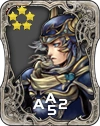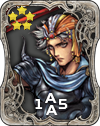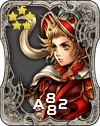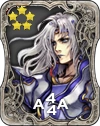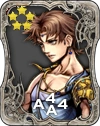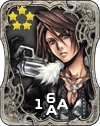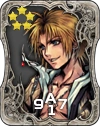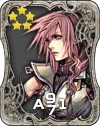No edit summary |
No edit summary |
||
| Line 84: | Line 84: | ||
*(1.0) The server Karnak referred to [[Karnak|a town of the same name]]. |
*(1.0) The server Karnak referred to [[Karnak|a town of the same name]]. |
||
*(1.0) During [[Caravan Security]], both "[[Boco]]" and "[[Koko]]" may appear as the [[chocobo]] names. Boco was [[Bartz Klauser]]'s steed in ''Final Fantasy V'' who during the game found a girlfriend named Koko. |
*(1.0) During [[Caravan Security]], both "[[Boco]]" and "[[Koko]]" may appear as the [[chocobo]] names. Boco was [[Bartz Klauser]]'s steed in ''Final Fantasy V'' who during the game found a girlfriend named Koko. |
||
| − | *The [[Scions of the Seventh Dawn]] is possibly named after the [[Warriors of Dawn]]. |
||
| ⚫ | *[[Gilgamesh (character)|Gilgamesh |
||
| ⚫ | |||
*[[Sastasha]] is a homage to the [[Pirates' Hideout]] from ''Final Fantasy V''. Both locations are the first dungeon. |
*[[Sastasha]] is a homage to the [[Pirates' Hideout]] from ''Final Fantasy V''. Both locations are the first dungeon. |
||
*The [[Guardian Tree (Final Fantasy XIV)|Guardian Tree]] can be found in the [[Black Shroud|Central Shroud]]. It's an allusion to the [[Guardian Tree (Final Fantasy V)|Guardian Tree]] on [[Planet R]] of ''Final Fantasy V''. |
*The [[Guardian Tree (Final Fantasy XIV)|Guardian Tree]] can be found in the [[Black Shroud|Central Shroud]]. It's an allusion to the [[Guardian Tree (Final Fantasy V)|Guardian Tree]] on [[Planet R]] of ''Final Fantasy V''. |
||
*In a later story quest, the player fights Siren on a beach surrounded by the hulls and flotsam of beached ships. The place is called "Ship Graveyard." A similar event happens in ''Final Fantasy V''. |
*In a later story quest, the player fights Siren on a beach surrounded by the hulls and flotsam of beached ships. The place is called "Ship Graveyard." A similar event happens in ''Final Fantasy V''. |
||
| − | *[[Gil Turtle (Final Fantasy XIV)|Gil Turtle]] appears in one of the [[Guildhest]]s. It is the pet of [[Teledji Adeledji]]. The [[Gil Turtle (Final Fantasy V)|Gil Turtle]] is originally an optional boss from the [[bonus dungeon]] [[Gil Cave]] in ''Final Fantasy V''. |
||
*A [[Krile Mayer Baldesion (Final Fantasy XIV)|character]] based on ''Final Fantasy V'' lead character [[Krile Mayer Baldesion]] appears, designed after her namesake in White Mage attire. |
*A [[Krile Mayer Baldesion (Final Fantasy XIV)|character]] based on ''Final Fantasy V'' lead character [[Krile Mayer Baldesion]] appears, designed after her namesake in White Mage attire. |
||
**Krile is also part of the "Students of Baldesion", a group of researchers formerly located on the Isle of Val. In ''Final Fantasy V'' Galuf and Krile hailed from the [[Castle of Bal|kingdom of Bal]] and their surname was "Baldesion". |
**Krile is also part of the "Students of Baldesion", a group of researchers formerly located on the Isle of Val. In ''Final Fantasy V'' Galuf and Krile hailed from the [[Castle of Bal|kingdom of Bal]] and their surname was "Baldesion". |
||
| + | *Krile's grandfather, Galuf, borrows his name from the original [[Galuf Halm Baldesion]] from ''Final Fantasy V''. In the Eureka storyline, it is revealed he traveled with companions named Xezat, Kelger, and Dorgann; being named after the other [[Warriors of Dawn]] that accompanied Galuf. |
||
| − | *Prior to Krile's debut in 3.1, [[Minfilia Warde|Minfilia]] speaks to her, via linkpearl in an underlain audio, after the Scions reunite and escape Castrum Centri together. After her audio is finished, there is a brief line where she says, "... My regards to grandfather." This references [[Galuf Halm Baldesion|Galuf]], another playable character in ''Final Fantasy V'' who is Krile's grandfather. |
||
| − | *[[ |
+ | *The [[Great Gubal Library]] instance dungeon is loosely based on the [[Library of the Ancients]] dungeon from ''Final Fantasy V''. The enemy [[Page 64 (Final Fantasy XIV)|Page 64]] and the boss [[Byblos (Final Fantasy XIV)|Byblos]] are based on the enemies of the same name encountered in the Library of the Ancients. |
| − | *[[ |
+ | *[[Omega (Final Fantasy XIV)|Omega]] appears as an ancient superweapon while [[Shinryu (Final Fantasy XIV)|Shinryu]] appears as a Primal, thus making them rivals just like in the lore of ''Final Fantasy V''. |
| ⚫ | |||
| ⚫ | |||
| ⚫ | |||
| ⚫ | *[[Gilgamesh (character)|Gilgamesh]] makes an appearance in the game and fights the [[Warrior of Light (Final Fantasy XIV)|adventurer]] during [[Hildibrand Manderville|Hildibrand]] storyline. A green chicken named [[Enkidu]] also appears alongside him in honor of his partner from ''Final Fantasy V''. Lastly, a primal in the form of the Enkidu from ''Final Fantasy V'' appears later in the story. |
||
| ⚫ | |||
*[[Catoblepas (Final Fantasy XIV)|Catoblepas]], the second boss of [[Halatali|Halatali (Hard Mode)]] is based on the [[Catoblepas (Final Fantasy V boss)|optional boss]] and [[Catoblepas (summon)#Final Fantasy V|summon]] from ''Final Fantasy V''. |
*[[Catoblepas (Final Fantasy XIV)|Catoblepas]], the second boss of [[Halatali|Halatali (Hard Mode)]] is based on the [[Catoblepas (Final Fantasy V boss)|optional boss]] and [[Catoblepas (summon)#Final Fantasy V|summon]] from ''Final Fantasy V''. |
||
| − | *[[The Second Coil of Bahamut - Turn 2#Bioweapon Storage|Melusine]], the boss of Turn 2 of the [[Second Coil of Bahamut]], is named after the [[Melusine (Final Fantasy V)|boss of the same name]] from ''Final Fantasy V''. |
||
*Atomos, a boss in the [[Labyrinth of the Ancients]], is based on the [[Atomos (Final Fantasy V)|boss of the same name]] from ''Final Fantasy V''. |
*Atomos, a boss in the [[Labyrinth of the Ancients]], is based on the [[Atomos (Final Fantasy V)|boss of the same name]] from ''Final Fantasy V''. |
||
| ⚫ | *Karlabos, the first boss of [[Sastasha|Sastasha (Hard)]], is based on the [[Karlabos (Final Fantasy V)|boss of the same name]] from ''Final Fantasy V''; additionally, his signature attack is Tail Screw, and like in ''Final Fantasy V'', it reduces the target's [[HP (stat)|HP]] to [[HP Critical|critical levels]]. |
||
*Ice Soldiers are summoned as additional enemies during the fight with [[Shiva (Final Fantasy XIV)|Shiva]], possibly in reference to the [[Ice Commander (Final Fantasy V)|Ice Commanders]] that fight alongside [[Shiva (Final Fantasy V boss)|Shiva]] in ''Final Fantasy V''. |
*Ice Soldiers are summoned as additional enemies during the fight with [[Shiva (Final Fantasy XIV)|Shiva]], possibly in reference to the [[Ice Commander (Final Fantasy V)|Ice Commanders]] that fight alongside [[Shiva (Final Fantasy V boss)|Shiva]] in ''Final Fantasy V''. |
||
| ⚫ | *Karlabos, the first boss of [[Sastasha|Sastasha (Hard)]], is based on the [[Karlabos (Final Fantasy V)|boss of the same name]] from ''Final Fantasy V''; additionally, his signature attack is Tail Screw, and like in ''Final Fantasy V'', it reduces the target's [[HP (stat)|HP]] to [[HP Critical|critical levels]]. |
||
| + | *Calofisteri, the final boss of [[The Weeping City of Mhach]], is based on [[Calofisteri (Final Fantasy V)|the boss of the same name]]. |
||
*Gaelicats in the [[Sea of Clouds]] area are based on [[Gaelicat (Final Fantasy V)|an enemy of the same name]] from ''Final Fantasy V''. |
*Gaelicats in the [[Sea of Clouds]] area are based on [[Gaelicat (Final Fantasy V)|an enemy of the same name]] from ''Final Fantasy V''. |
||
*[[Bandersnatch (Final Fantasy XIV)|Bandersnatches]] in [[Dravania]] territories have the same design as their ''Final Fantasy V'' [[Bandersnatch (Final Fantasy V)|counterparts]]. |
*[[Bandersnatch (Final Fantasy XIV)|Bandersnatches]] in [[Dravania]] territories have the same design as their ''Final Fantasy V'' [[Bandersnatch (Final Fantasy V)|counterparts]]. |
||
| ⚫ | *There is a sidequest in [[Dravanian Forelands]] that the player has to obtain a bunch of Wyvern Tails, a grass-like plant found growing on the northern hills, and used it to heal a wyvern's wounds. In ''Final Fantasy V'' the party must venture to [[Drakenvale]] to find dragon grass to heal a [[wind drake]]. |
||
| − | *The [[Great Gubal Library]] instance dungeon is loosely based on the [[Library of the Ancients]] dungeon from ''Final Fantasy V''. The enemy [[Page 64 (Final Fantasy XIV)|Page 64]] and the boss [[Byblos (Final Fantasy XIV)|Byblos]] are based on the enemies of the same name encountered in the Library of the Ancients. |
||
| − | *The Liquid Flame and Living Liquid bosses can transform into three forms: human form, hand form, and tornado form, alluding to the [[Liquid Flame (Final Fantasy V)|Liquid Flame]] in the [[Fire-Powered Ship]]. |
||
*The Enchanted Fan enemies in [[Sohr Khai]] are based on the [[Enchanted Fan (Final Fantasy V)|enemy of the same name]] from ''Final Fantasy V''. |
*The Enchanted Fan enemies in [[Sohr Khai]] are based on the [[Enchanted Fan (Final Fantasy V)|enemy of the same name]] from ''Final Fantasy V''. |
||
| − | * |
+ | *The Liquid Flame and Living Liquid bosses can transform into three forms: human form, hand form, and tornado form, alluding to the [[Liquid Flame (Final Fantasy V)|Liquid Flame]] battle in the [[Fire-Powered Ship]]. |
| − | *[[Omega (Final Fantasy XIV)|Omega]] appears as an ancient superweapon while [[Shinryu (Final Fantasy XIV)|Shinryu]] appears as a Primal, thus making them rivals just like in the lore of ''Final Fantasy V''. |
||
| ⚫ | |||
| ⚫ | |||
| ⚫ | |||
| ⚫ | |||
*The Interdimensional Rift is a direct reference to the final dungeon of ''Final Fantasy V''. The background music is an arrangement of "Prelude to the Void" and the boss battle theme is an arranged version of "Battle 2". |
*The Interdimensional Rift is a direct reference to the final dungeon of ''Final Fantasy V''. The background music is an arrangement of "Prelude to the Void" and the boss battle theme is an arranged version of "Battle 2". |
||
*The bosses of The Deltascape raids are based on ''Final Fantasy V'' bosses: [[Alte Roite (Final Fantasy V)|Alte Roite]], [[Catastrophe (Final Fantasy V)|Chatastrophe]], [[Halicarnassus (Final Fantasy V)|Halicarnassus]], and [[Exdeath]]. For the last boss, Exdeath, an arrangement of "The Decisive Battle" serves as the background music. |
*The bosses of The Deltascape raids are based on ''Final Fantasy V'' bosses: [[Alte Roite (Final Fantasy V)|Alte Roite]], [[Catastrophe (Final Fantasy V)|Chatastrophe]], [[Halicarnassus (Final Fantasy V)|Halicarnassus]], and [[Exdeath]]. For the last boss, Exdeath, an arrangement of "The Decisive Battle" serves as the background music. |
||
*Exdeath uses the power of the [[Void (Final Fantasy V)|Void]] in battle. Furthermore, the animation of his Flare and Holy are based on their ''Final Fantasy V'' versions. |
*Exdeath uses the power of the [[Void (Final Fantasy V)|Void]] in battle. Furthermore, the animation of his Flare and Holy are based on their ''Final Fantasy V'' versions. |
||
| ⚫ | |||
| ⚫ | |||
| ⚫ | *There is a sidequest in [[Dravanian Forelands]] that the player has to obtain a bunch of Wyvern Tails, a grass-like plant found growing on the northern hills, and used it to heal a wyvern's wounds. In ''Final Fantasy V'' the party must venture to [[Drakenvale]] to find dragon grass to heal a [[wind drake]]. |
||
| ⚫ | |||
| ⚫ | |||
*The [[Isle of Val]] was implemented in version 4.21, also known as "The Forbidden Land, Eureka". There're locations on this island named after ''Final Fantasy V'' characters: Port Surgate, Klauser's Howe, The Val River Swale, and Klauser's Peace. |
*The [[Isle of Val]] was implemented in version 4.21, also known as "The Forbidden Land, Eureka". There're locations on this island named after ''Final Fantasy V'' characters: Port Surgate, Klauser's Howe, The Val River Swale, and Klauser's Peace. |
||
*Artifact gears for [[Blue Mage (Final Fantasy XIV)|Blue Mage]] are based on the job's ''Final Fantasy V'' counterpart. |
*Artifact gears for [[Blue Mage (Final Fantasy XIV)|Blue Mage]] are based on the job's ''Final Fantasy V'' counterpart. |
||
| ⚫ | |||
*The casting effect of Blue Magics is based on ''Final Fantasy V'' Blue Magic casting. |
*The casting effect of Blue Magics is based on ''Final Fantasy V'' Blue Magic casting. |
||
| − | *In the first cutscene battle as a Blue Mage, the player character has to fight with nothing but using a rod as a melee weapon. This alluded to how Blue Mage is in ''Final Fantasy V'' when they have yet to learn any spell. |
||
| ⚫ | |||
| ⚫ | |||
| ⚫ | |||
| ⚫ | |||
==''[[Final Fantasy VI]]''== |
==''[[Final Fantasy VI]]''== |
||
Revision as of 00:38, 24 January 2020
Template:Sideicon
The following is a list of allusions to other entries in the Final Fantasy series present in Final Fantasy XIV.
Final Fantasy series
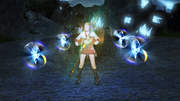
Four crystals appear while using the ability Swiftcast.
- (1.0) Near the end of the cutscene in which Gaius fought Thancred, Y'shtola, Yda, and Papalymo, the four Circle of Knowing members stood a distance from him in a small row. This could be a visual reference to how parties used to stand in rows in the first ten Final Fantasy games.
- Four crystals appear during the animation of Thaumaturge ability, Swiftcast, alluding to the four crystals in early Final Fantasy titles.
- In the various promotional screenshots, names of various playable characters from previously released games were used to name the characters.
- A miniature classic airship can be obtained as a pet, as well as a "pointing finger" similar to those used as a cursor in previous entries of the series.
- The CG renders and concept art for the Summoner of Final Fantasy XIV: A Realm Reborn show the summoner with a horn-like adornment on his head, echoing how summoners with forehead horns appear in various Final Fantasy titles. The horn is also present in the class's Artifact Armor.
- The 2013 All Saints Wake (Halloween) event features a Magic Pot NPC. It resembles the imps of Final Fantasy XI and Final Fantasy XIV hiding in the conventional urn. When players interact with it, it boasts that the Impressario gave it an Elixir and rocks backward gleefully. Magic Pot is a recurring enemy in the series that yields excellent spoils if appeased with an Elixir. There is also a Magic Pot NPC in the Isles of Umbra that gives you the wind-up sun minion if you give it an elixir.
- Entering most storyline battles initiates the common "whoosh" effect of previous games' random encounters.
- When completing to quest to obtain a Zodiac Weapon Zeta, the "Got an Important Item" jingle plays.
Final Fantasy
- (1.0) The server Cornelia referred to city and kingdom of the same name.
- (1.0) The server Melmond referred to a village of the same name.
- Matoya along with her cave and theme tune are alluded to Matoya from the original title. One of the main scenario quests in Final Fantasy XIV: Heavensward is also titled "Matoya's Cave."
- During certain moments of the main scenario, the Warrior of Light and their companions seek the aid of Matoya's Crystal Eye, an ancient crystal ball item that allows the party to find their missing allies. This crystal serves as a reference to the item of the same name that Matoya owned in the original Final Fantasy.
- Mount Gulg appears as the level 79 dungeon in the Shadowbringers main scenario.
- Chaos appears as the boss of the Alphascape V1.0 raid instance. He is fought within a destroyed version of the Chaos Shrine. Like his original final boss encounter, his mechanics involve him casting Blaze, Tsunami, Cyclone, and Earthquake.
- In addition, Chaos summons an enemy known as the Dark Crystal during the interlude portion of the fight. This is a reference to the relic of the same name that rested inside the Chaos Shrine in the original Final Fantasy.
- The Warrior of Light's helmet is obtainable for those who purchased the Collector's Edition with the rest being available from the Crystal Tower dungeon.
- The "Wind-up Warrior of Light" minion is based on Yoshitaka Amano's artwork of the Warrior of Light.
- "The Minion of Light," a set of minions based on the Warrior, the White Mage, and Black Mage sprite artwork from the V-Jump strategy guide for the original Famicom version can be obtained as an achievement reward.
Final Fantasy II
- (1.0) The servers Kashuan and Palamecia alluded to, respectively, the kingdom and empire of the same name in Final Fantasy II.
- Minfilia, the leader of the Scions of the Seventh Dawn, uses the password "wild rose" to allow the player to identify other members of the order. This phrase was used by Princess Hilda of Fynn to identify other members of the rebels against the Empire.
- A soundtrack used in multiple places, such as during the main storyline in Ul'dah, is a remix of the battle theme of Final Fantasy II.
- "Dreadnought" is one of the Empire's airships.
- Talking beavers appear in Il Mheg as a type of fey creature.
- Firion's outfit is available for player characters as a Rank 11 Veteran Reward for players who subscribed for 840 days in total. In addition, a set of chocobo barding based on Firion's outfit, as well as a Wind-up Firion minion, are available as achievement rewards.
Final Fantasy III
- (1.0) The server Gysahl referred to a village of the same name.
- (1.0) The server Saronia referred to a kingdom of the same name.
- Cid Garlond's airship is named Enterprise. Enterprise first appeared as a name for an airship in Final Fantasy III.
- The Crystal Tower dungeon quests are inspired by the Crystal Tower from Final Fantasy III from the Labyrinth of the Ancients, referring to the Ancients' Maze, to Syrcus Tower. The dungeon is home to various bosses that pay homage to Final Fantasy III enemies. The Labyrinth of the Ancients holds Thanatos, King Behemoth, and Phlegethon (named Titan in Japanese), whereas Syrcus Tower has Scylla, Glasya Labolas (named Guardian in Japanese), Amon, and Xande. The Cloud of Darkness appears along with the World of Darkness as the final boss of the Crystal Tower arc. The themes "Altar Cave," "Battle 2," and "The Crystal Tower" have been rearranged for the raids.
- When casting his ability, Glasya Labolas will make the same pose as his Final Fantasy III sprite.
- Xande's obsession with his mortality and fear of the inevitable lead him to make a pact with a being from the void, the Cloud of Darkness, mirroring his ambitions in Final Fantasy III.
- Doga and Unei are named after the two sages from Final Fantasy III.
- The historical figures from the Allagan Empire are named Desch and Salina, referencing the original Desch and Salina from Final Fantasy III.
- The Wind-up Magus and Wind-up Viking enemies inside of the Antitower are based on the Magus and Viking jobs, being based on their sprites from the original NES version.
- The Warriors of Darkness are based on the characters of the same name from Final Fantasy III. Similar to the characters they are based on, Arbert and his companions come from a world that is being consumed by the Flood of Light.
- In addition, the job titles for Arbert's companions are from the jobs in Final Fantasy III: Devout, Magus, Ranger and Knight. However, due to Knight being used as the Japanese name for Paladin job in Final Fantasy XIV, Blanhaerz's job title in Japanese is instead Magic Swordsman (魔法剣士, Mahōkenshi?), using the Japanese name for the Dark Knight job in Final Fantasy III.
- The Onion Helm is a helmet available to players who purchased the Collectors Edition of the original game, the rest of the Onion equipment is available as prizes in the Crystal Tower. Onion equipment debuted in Final Fantasy III with the Onion Knight job.
- The Artifact Equipment for the Summoner job class is called the "Evoker's equipment" and the upgraded version is the "Summoner's equipment", alluded to the job Evoker and its upgraded version, the Summoner from Final Fantasy III.
- All of the weapons that can be purchased with Rowena Tokens gained from the quest Primal Focus are named from weapons in Final Fantasy III. All of the weapons in Final Fantasy III are used by the job that equips them in Final Fantasy XIV with the exception of two: the Elder Staff and Omnirod are swapped, the Elder Staff is used by white mages and the Omnirod is used by black mages (in Final Fantasy III).
- According to the Final Fantasy XIV: Heavensward | The Art of Ishgard – Stone and Steel – artbook, the Orison set of equipment for the White Mage job is based on the White Mage robe.
- The minion "Wind-up Onion Knight" can be found in a treasure chest after the party defeats Xande. It's a minion based on the original NES sprite of the Final Fantasy III Onion Knight.
- Nepto Dragon can be fished by Fisher class, named after the creature from the original game.
Final Fantasy IV
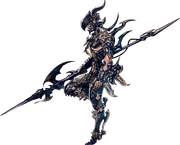
Dragoon artwork with Kain Highwind's famous pose.
- (1.0) The server Mysidia referred to a village of the same name.
- (1.0) The server Fabul referred to a kingdom of the same name.
- The Artifact Armor for Dragoon is a reference to Kain Highwind's armor. The artwork of the Dragoon job shares the same pose as Kain in the original logo of Final Fantasy IV.
- Nidhogg's second stage in The Final Steps of Faith, which sees him take the form of Estinien Wyrmblood, strikes the same pose as Kain's logo in his passive stance.
- A weather vane seen in the Final Fantasy XIV: Heavensward cinematic is shaped like Yoshitaka Amano's original Final Fantasy IV logo featuring Kain Highwind.
- The final boss of the Antitower, Calcabrina, is a reference to the dancing doll demon Calcabrina, even sharing the same theme music.
- The final boss of The Burn, Mist Dragon is a reference to Mist Dragon
- The dwarf village of Tomra in the Kholusia region is named after the dwarf village of the same name from Final Fantasy IV.
- The non-playable character for the Bard quests says the phrase "Call me a spoony bard, but...", in reference to the famous one-liner from Tellah.
- The players will encounter a "darkness" version of themselves during one of the Dark Knight job quests, similar to the event in Final Fantasy IV.
- The healer role quest giver in Shadowbringers is a dwarf NPC named Giott, borrowing their name from King Giott from Final Fantasy IV.
- The Allagan ADS enemies are based on the CPU boss from Final Fantasy IV.
- The first final boss of Pharos Sirius (Hard), the Progenitrix, is based on the Mom Bomb boss from Final Fantasy IV. In the Japanese version, the boss is called "Mother Bomb" (マザーボム, Mazā Bomu?). Like in the original game, she also spawns Grey Bombs.
- The Artemis' Bow, the Relic Weapon for Bards, was long ago crafted specifically for a man named Gilbert, which is the Japanese name for the character Edward Chris von Muir, who was a Bard.
- Cecil's Paladin headband and earrings could be obtained by pre-ordering Final Fantasy XIV: Heavensward.
- The final line on the card that provides the item code is "May they take you back to a time when two was four and four was two," a reference to how Square titled the SNES version of Final Fantasy IV as Final Fantasy II for the western market.
- The Tantra set of equipment for Monk job is based on Yang Fang Leiden's Yoshitaka Amano's artwork.
Final Fantasy IV -Interlude-
- The second final boss of Pharos Sirius (Hard), the Progenitor, is based on the Dad Bomb boss from Final Fantasy IV -Interlude-. In the Japanese version, the boss is called "Father Bomb" (ファザーボム, Fazā Bomu?).
Final Fantasy V
- (1.0) The server Istory referred to a town of the same name.
- (1.0) The server Karnak referred to a town of the same name.
- (1.0) During Caravan Security, both "Boco" and "Koko" may appear as the chocobo names. Boco was Bartz Klauser's steed in Final Fantasy V who during the game found a girlfriend named Koko.
- Sastasha is a homage to the Pirates' Hideout from Final Fantasy V. Both locations are the first dungeon.
- The Guardian Tree can be found in the Central Shroud. It's an allusion to the Guardian Tree on Planet R of Final Fantasy V.
- In a later story quest, the player fights Siren on a beach surrounded by the hulls and flotsam of beached ships. The place is called "Ship Graveyard." A similar event happens in Final Fantasy V.
- A character based on Final Fantasy V lead character Krile Mayer Baldesion appears, designed after her namesake in White Mage attire.
- Krile is also part of the "Students of Baldesion", a group of researchers formerly located on the Isle of Val. In Final Fantasy V Galuf and Krile hailed from the kingdom of Bal and their surname was "Baldesion".
- Krile's grandfather, Galuf, borrows his name from the original Galuf Halm Baldesion from Final Fantasy V. In the Eureka storyline, it is revealed he traveled with companions named Xezat, Kelger, and Dorgann; being named after the other Warriors of Dawn that accompanied Galuf.
- The Great Gubal Library instance dungeon is loosely based on the Library of the Ancients dungeon from Final Fantasy V. The enemy Page 64 and the boss Byblos are based on the enemies of the same name encountered in the Library of the Ancients.
- Omega appears as an ancient superweapon while Shinryu appears as a Primal, thus making them rivals just like in the lore of Final Fantasy V.
- The Sirensong Sea dungeon is inspired by the Ship Graveyard.
- The First was once home to an ancient civilization known as the Ronka, who left a number of ruins behind, a reference to the Ronka Ruins.
- The Night's Blessed's original settlement, Fort Gohn, is named after the village of the same name from Final Fantasy V. Similar to the original, Fort Gohn is a ruined village that is located near the ruins of the ancient Ronkan civilization.
- Gilgamesh makes an appearance in the game and fights the adventurer during Hildibrand storyline. A green chicken named Enkidu also appears alongside him in honor of his partner from Final Fantasy V. Lastly, a primal in the form of the Enkidu from Final Fantasy V appears later in the story.
- In the cutscene just before the second phase of the "Battle in the Big Keep" trial, Gilgamesh recites almost verbatim his pre-battle lines from Final Fantasy V.
- Catoblepas, the second boss of Halatali (Hard Mode) is based on the optional boss and summon from Final Fantasy V.
- Atomos, a boss in the Labyrinth of the Ancients, is based on the boss of the same name from Final Fantasy V.
- Ice Soldiers are summoned as additional enemies during the fight with Shiva, possibly in reference to the Ice Commanders that fight alongside Shiva in Final Fantasy V.
- Karlabos, the first boss of Sastasha (Hard), is based on the boss of the same name from Final Fantasy V; additionally, his signature attack is Tail Screw, and like in Final Fantasy V, it reduces the target's HP to critical levels.
- Calofisteri, the final boss of The Weeping City of Mhach, is based on the boss of the same name.
- Gaelicats in the Sea of Clouds area are based on an enemy of the same name from Final Fantasy V.
- Bandersnatches in Dravania territories have the same design as their Final Fantasy V counterparts.
- The Enchanted Fan enemies in Sohr Khai are based on the enemy of the same name from Final Fantasy V.
- The Liquid Flame and Living Liquid bosses can transform into three forms: human form, hand form, and tornado form, alluding to the Liquid Flame battle in the Fire-Powered Ship.
- The Interdimensional Rift is a direct reference to the final dungeon of Final Fantasy V. The background music is an arrangement of "Prelude to the Void" and the boss battle theme is an arranged version of "Battle 2".
- The bosses of The Deltascape raids are based on Final Fantasy V bosses: Alte Roite, Chatastrophe, Halicarnassus, and Exdeath. For the last boss, Exdeath, an arrangement of "The Decisive Battle" serves as the background music.
- Exdeath uses the power of the Void in battle. Furthermore, the animation of his Flare and Holy are based on their Final Fantasy V versions.
- The Azulmagia final boss of the Masked Carnival serves as a reference to the Blue Mage enemy of the same name. In addition, players receive his signature cane as the level 50 Blue Mage weapon.
- The final boss of the Twinning dungeon is named The Tycoon, being named after kingdom of the same name from Final Fantasy V. Due to the enemy being a palette swap of the castle-like primal Alexander, the enemy's name is a reference to Castle Tycoon.
- There is a sidequest in Dravanian Forelands that the player has to obtain a bunch of Wyvern Tails, a grass-like plant found growing on the northern hills, and used it to heal a wyvern's wounds. In Final Fantasy V the party must venture to Drakenvale to find dragon grass to heal a wind drake.

Moai face underwater.
- There is a moai face in the Lochs in the Stormblood expansion, alluding to the moai statue at the bottom of the ocean in Final Fantasy V.
- The Isle of Val was implemented in version 4.21, also known as "The Forbidden Land, Eureka". There're locations on this island named after Final Fantasy V characters: Port Surgate, Klauser's Howe, The Val River Swale, and Klauser's Peace.
- Artifact gears for Blue Mage are based on the job's Final Fantasy V counterpart.
- Ghido minion can be obtained from the last treasure chest in The Sirensong Sea. It is based on the turtle sage Ghido and will fight with the Wind-up Exdeath minion.
- The casting effect of Blue Magics is based on Final Fantasy V Blue Magic casting.
Final Fantasy VI

A Terra lookalike in the Magitek Armor trailer for Final Fantasy XIV: A Realm Reborn.
- (1.0) The server Figaro referred to a kingdom of the same name.
- (1.0) During the 2011 All Saints Wake (Halloween) event, the trickster imps would randomly say "Life... Dreams... Imps... Where do they come from? And where do they go?" upon spawning, quoting Kefka's speech during the final battle of Final Fantasy VI.
- The Garlean Empire technology is called magitek, and has advanced considerably due to the works of a Cid and is primarily used for military purposes. Additionally, two versions of the Magitek Armor mount is available to players: one based more on Yoshitaka Amano's "armless" design seen in concept art, and the "armored suit with arms" design seen in the game as printed. In Final Fantasy VI, magitek technology is employed by the Gestahlian Empire, invented by the engineer Cid Del Norte Marquez.
- When Cid nan Garlond is suffering from amnesia, he goes by the name Marques, referring to the Cid from Final Fantasy VI.
- The first video showing the Magitek Armor in-game was a short recreation of the opening to Final Fantasy VI, with a green haired female hyur and two other characters riding the Magitek Armor in a snowy region, and a remix of "Terra's Theme" playing in the background. As of Patch 2.55, the remix of "Terra's Theme" is now the mount music for the Magitek Armor.
- There's a Gladiator skill called "Riot Blade," a Rogue skills called "Spinning Edge" and "Shadow Fang," and a Dragoon Jump named "Mirage Dive." These skills are named after the Desperation Attacks of Terra, Celes, Shadow and Locke.
- The 2013 All Saints Wake (Halloween) event features a circus troupe led by a man named "The Impressario," alluding to an NPC of the same name in the Opera House of Final Fantasy VI.
- There is a Phantom Train linking several Garlean Castra. During the main story quest "Escape from Castrum Centri," Yda and Y'shtola sneak into the Imperial stronghold using the train, and a depot is briefly visited during runs through Castrum Meridianum. Phantom Train was a supernatural train in Final Fantasy VI that the party accidentally boards and must escape from.
- Doma is the name of a nation-state far across the sea from Eorzea, and when it resists the control of the Empire, it is wiped out as an example to other nations. Doma in Final Fantasy VI is also wiped out after resisting the Gestahlian Empire. In addition to this, like its Final Fantasy VI counterpart, Doma appears to be based on feudal Japan.
- Both the former Doman king, Kaien and the prince, Hien, are direct references to the characters Cyan Garamonde and his son Owaine. Kaien's name is based on the romaji of Cyan's Japanese name, Cayenne (カイエン, Kaien?), while Hien's childhood name, Shun, is based on Owaine's Japanese name, which is also Shun (シュン, Shun?). An arrangement of "Cyan's Theme" plays as Hien's character theme.
- The party found Hien on a cliff similar to how Cyanne was found in the World of Ruin in Final Fantasy VI.
- An airship named Blackjack appears during the Ixal quests. Blackjack was Setzer Gabbiani's airship in Final Fantasy VI.
- The Falcon is an available mount as of Stormblood. A reference to Daryl claiming it is the fastest airship in the world is in the tooltip.
- Ultros and Typhon make a cameo appearance as optional bosses in Hildibrand storyline. The original version of "The Decisive Battle" theme plays during the battle against them. Ultros is a recurring boss and comic relief character in Final Fantasy VI who has a friend named Typhon.
- Ultros also uses direct quotes from Final Fantasy VI several times during his cutscenes.
- Setzer Gabbiani's costume can be bought in Manderville Gold Saucer.
- Moglin, Moghan, and Mogwin are named after the moogles from Final Fantasy VI.
- The Gestahl dog minion is a reference to a joke where the Emperor Gestahl sprite in Final Fantasy VI looked like a dog.
- The floating continent of Azys Lla is inspired by the Floating Continent from Final Fantasy VI. The connection is further established by several nods:
- The Garlean Legion encountered in Azys Lla is the VIth Legion.
- "Proto Ultima," a creature based on the Ultima Weapon, can be seen flying around the continent. The Ultima Weapon is a boss fought on the Floating Continent in Final Fantasy VI.
- The Aetherochemical Research Facility dungeon in Azys Lla is inspired by the Magitek Research Facility from Final Fantasy VI. It houses three primals known as the Warring Triad.
- The Allag flagship on which the Aetherochemical Research Facility is stationed bears golden statues of the Warring Triad around a tower-like object. The Warring Triad were petrified deities and the origin of magic in Final Fantasy VI. The first boss theme of Sephirot, the Fiend, is a remix of Battle to the Death, the boss theme that plays when fighting the Warring Triad in Final Fantasy VI.
- Ymir appears as a boss in the Hullbreaker Isle (Hard). A group of Ymir Unshelled also appear in the cave before the boss room of Ymir.
- The first boss of Dun Scaith is "Deathgaze Hollow", whose battle occurs on the deck of an airship. This alludes to the battle against Deathgaze in Final Fantasy VI.
- The Stormblood dungeon, Castrum Abania has many enemies and bosses from Final Fantasy VI, including but not limited to the Magna Roader, Number 024, and Inferno each possessing many of the same attacks and battle strategies.
- Kefka also appears as the final boss of the fourth version of Sigmascape, being preceded by Phantom Train, Chadarnook, and Guardian alluding to his role as the main antagonist in Final Fantasy VI. He also uses various lines from both the SNES/PSX as well as the GBA/iOS/Steam versions of Final Fantasy VI during his fight against the party. During the final phase, Nero tol Scaeva when Kefka uses Forsaken for the first time will state "He's gone beyond chaos... the end approaches!" alluding to Kefka's line in the SNES version when charging up the attack, "The end comes... beyond chaos...".
- The appearance of the Ultima Beast, a prototype Ultima Weapon fought in the Fractal Continuum (Hard), is based on the version of the Ultima Weapon from Final Fantasy VI.
- A Lupin going by the moniker "The Wolf Burgler" appears in the Hildibrand story, at one point forcing you to choose between your ally or the precious item falling from a cliff much like in VI.
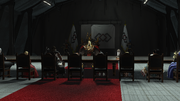
A parley between Eorzean Alliance and Emperor Varis.
- Later in the Stormblood main scenario, there's a meeting between the Eorzean Alliance and Emperor Varis zos Galvus, this event resembles the event where The Returners have a dinner with Emperor Gestahl. The parley also splitted into two parts with a short break where the player can talk to the NPCs around the place.
Final Fantasy VII
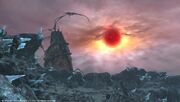
The fall of Dalamud event alludes to Meteor in Final Fantasy VII.
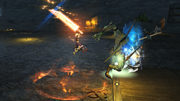
The Buster Sword appears while using Limit Break "Braver".
- (1.0) The server Wutai referred to a nation of the same name from Final Fantasy VII.
- (1.0) When the player underwent the first "Horn & Hand" faction leve, a NPC said the following: "Why, if it isn't Sephiroth! Or was it Sephiross? Setirophx? xXxSephirothxXx?", referring to Sephiroth and common variations used to name characters on MMOs (and by proxy, Final Fantasy XIV itself—although of comical note is due to the game's naming conventions, some of the variations are not possible in XIV itself).
- (1.0) An NPC in the Miner quests mistakenly called players by the wrong name. He called a Midlander Hyur "Cloud," and a Miqo'te "Aerith," both main characters from Final Fantasy VII.
- (1.0) There were two references to the Final Fantasy VII main antagonist Sephiroth, both of which are made by main antagonist Nael van Darnus (and might explain why she is designated the Legatus of the VIIth Legion):
- In "United We Stand," after wounding the player, Nael took her leave similarly to that of Sephiroth in the Nibelheim burning scene.
- Nael sought to destroy Eorzea and subsequently purify it by using forbidden magicks to summon the Meteor-like moon, Dalamud. Sephiroth similarly attempts to destroy Gaia by using the Black Materia to summon Meteor in Final Fantasy VII. Both do so because they feel it is their birthright and duty.
- One of the Cactuar enemies is called Sabotender Del Sol after the location Costa del Sol in Final Fantasy VII.
- A small resort town named Costa del Sol is located in La Noscea, named after a similar place in Final Fantasy VII.
- The Materia crafting system is named after and inspired by Final Fantasy VII Materia.
- Various Limit Breaks that originate from Final Fantasy VII appear: Final Heaven, Braver, Healing Wind, Breath of the Earth, Pulse of Life, Catastrophe and Doom of the Living.
- Cloud's Buster Sword is used when the player performs Braver and Sword Dance, the level 2 melee limit break.
- A light form of Aeris's Guard Stick is used when the player performs healer Limit Breaks as a White Mage.
- During the quest "The Company You Keep," the magitek engineers, Biggs and Wedge, are found at the crash site of an airship called the Tiny Bronco. Tiny Bronco was Cid Highwind's airplane in Final Fantasy VII.
- Cloud Strife, Tifa Lockhart, and Aerith Gainsborough's names are used in example sentences for the chat log filtering configuration (with Cloud often being the butt of many jokes in the examples).
- The design for Ultima Weapon is similar to that of Ultimate Weapon in Final Fantasy VII, one of the Weapons awakened by Sephiroth.
- After construction upgrades were done to Revenant's Toll, it now features a tavern called "Seventh Heaven"—named after the bar and restaurant owned and run by Tifa Lockhart in Final Fantasy VII. The owner jokes that she was going to call the bar "Cloud Nine," but thought it would be too effeminate for the clientele.
- Patch 2.3 introduced an NPC named Jessie as a member of Garlond Ironworks, a reference to the AVALANCHE member of the same name from Final Fantasy VII. They have a similar hairstyle.
- One of Gilgamesh's weapons he uses during the Battle in the Big Keep appears to be Sephiroth's Masamune.
- The quote of the Cait Sith Doll minion is "What may be a few to you was everything to those who died...", a line Cait Sith said to Barret in Final Fantasy VII in regard to collateral damage caused by AVALANCHE.
- While between missions during the Dreams of Ice story missions, Yda Hext competes at squats with Hoary Boulder, referring to the minigame from Final Fantasy VII. Several NPCs can also be seen performing squats in the same fashion.
- Manderville Gold Saucer is inspired by the Gold Saucer from Final Fantasy VII.
- The primal King Thordan and his Knights Twelve allude to the Knights of the Round from Final Fantasy VII.
- During the final battle, their attacks go off in the same order as the summon animation in Final Fantasy VII.
- After the last attack of Ultimate End the screen "shatters."
- The achievement for defeating Sephirot on Extreme difficulty is "Veni, Veni, Venias", a line from "One-Winged Angel".
- The Japanese name of the Savage variant of the Second Coil of Bahamut is the "Great Labyrinth of Bahamut Type-0" (大迷宮バハムート零式, Dai Meikyuu Bahamūto Reishiki?), referring to the Japanese name of the Bahamut ZERO summon, who first appeared in Final Fantasy VII.
- Dark Knight's victory pose resembles Cloud's victory pose.
- Samurai's victory pose for male characters resembles Sephiroth's victory pose.
- The Gentleman's Pose resembles the flexing animation of the NPCs in Beginner's (Intermediate) Hall.
- The first boss of Ala Mhigo duty, Magitek Scorpion, is modeled after Guard Scorpion. An NPC in the dungeon similarly references Cloud's battle text to "Attack when the tail is up," which will force the boss' tail laser to end earlier. (This also pokes fun at players who did not wait for the second text box to appear in the boss battle in the original game, where it would explain that attacking the boss while its tail was up would cause it to counter-attack. The second text box would not appear if the user used magic, summon, etc. before or during the explanation.)
- A sidequest storyline in The Fringes involves a Miqo'te who believes that his father abandoned him as a coward. He later learns that, in reality, his father died protecting their village from monsters whose poison turned him to stone. This alludes to the story of Red XIII and his father.
- The city of Eulmore contains a pleasure club known as "The Beehive", the bonded workers who dance in the club are known as "honeybees". The club and the name of the dancers are a reference to the Honey Bee Inn from Final Fantasy VII.
- The antagonist from the Shadowbringers expansion, Vauthry, was infused with the essence of a Lightwarden while within his mother's womb to augment him and grant him the ability to control sin eaters. Vauthry believes the world is rightfully his to rule as a god. These elements mirror Sephiroth's role in Final Fantasy VII, including being injected with Jenova cells while Lucrecia Crescent was still pregnant with him, and believing Gaia is rightfully his and Jenova's. Similar to Sephiroth, Vauthry's ascended form has angelic traits.
- The city of Amaurot is similar to the Forgotten City, with both locations being the home to a race known as the "Ancients", and are both located within a coral valley environment.
- During the finale of the Shadowbringers main scenario questline, Emet-Selch reveals to the Warrior of Light his true identity as Hades. His first form's appearance is heavily inspired by the summon's appearance in Final Fantasy VII and even has access to the summon's Black Cauldron ability as his final enrage attack.
Final Fantasy VIII
- (1.0) The server Trabia referred to continent and Garden of the same name.
- (1.0) The battle theme of the Black Shroud area, "The Forest's Pulse" may have been inspired by "The Man with the Machine Gun."
- Zell Dincht's tattoo is available in Character Creation mode.
- One of the Garlean Empire's main infantry weapons is a variant of a gunblade, a weapon originating from Final Fantasy VIII, though the functionality is different from those seen in VIII.
- The Gunbreaker class is heavily based on Squall Leonhart and Seifer Almasy, using a different style of gunblade than the Garlean models based on the Final Fantasy VIII version.
- The Keen Edge, No Mercy, Brutal Shell, Demon Slice, Lightning Shot, Solid Barrel, Rough Divide, Gnashing Fang, Savage Claw, Fated Circle, and Blasting Zone abilities used by Gunbreakers are all based on abilities used by either Squall or Seifer in Final Fantasy VIII or their crossover appearances.
- Eyes on Me is an enemy ability used by All-Seeing Eye, the boss in Dzemael Darkhold. It also the name of a quest from the main storyline, given to the player by Marques. These refer to the theme song from Final Fantasy VIII.
- Tonberry King is the final boss of the Wanderer's Palace, referring to the boss in Final Fantasy VIII.
- Diabolos is the final boss of the Lost City of Amdapor, and its appearance and entrance (emerging from a dark orb, surrounded by bats) strongly resemble that of its Final Fantasy VIII incarnation.
- The Double and Triple abilities are used by certain Ascians during specific boss encounters, like the same spells that first appeared in Final Fantasy VIII, allow the user to cast magic multiple times. The animations for the abilities strongly resemble the Double and Triple spell animations originally used in Final Fantasy VIII.
- The Triple Triad card game originates from Final Fantasy VIII.
- One of the Leatherworking tradecraft levequests added in Heavensward is called "Maybe He's A Lion."
- Squall's outfit is available to players as Rank 14 Veterans Reward for subscribing for at least 1,440 days.
- Quetzalcoatl is a boss in the Akadaemia Anyder, using its appearance from Final Fantasy VIII. Its intro cutscene refers to it as a Guardian Force.
- The giants in Amaurot seem to be modeled after the faculty members of Balamb Garden in Final Fantasy VIII.
- Eden is the focus of a raid series, replete with the special attack Eternal Breath, recreated from the Final Fantasy VIII summon animation. The tracks "Blue Fields" and "Force Your Way" play during it.
Final Fantasy IX
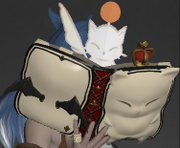
The Majestic Mogtome with a pop-up quill-wielding moogle.
- (1.0) The server Lindblum referred to the regency of the same name.
- (1.0) One guildleve objective was to retrieve the cargo of an airship named Red Rose. Red Rose is Queen Brahne's airship in Final Fantasy IX.
- (1.0) An NPC in the Miner quests mistakenly called players by the wrong name, calling a Miqo'te "Quina", the playable character from Final Fantasy IX.
- The Moogle Mail system is similar to the Mognet in Final Fantasy IX.
- In Aleport, Western La Noscea, there is a winged mermaid statue close to identical to the one serving as the figurehead of the Prima Vista of the Tantalus Theater Troupe in Final Fantasy IX.
- The Majestic Mogtome item, when unsheathed, is opened to reveal a pop-up moogle with a quill at the top, resembling the Save Moogles of Final Fantasy IX when viewed from the outside of the book.
- During Battlecraft Temple Leves in the Coerthas Western Highlands, the player may encounter a Zahgnol as a Wanted Target. The Zaghnol was the final enemy the player had to defeat during the Festival of the Hunt in Lindblum.
- Ozma, one of the bosses in The Weeping City of Mhach, is based on the superboss of the same name.
- The Hildibrand chain of quests in the Heavensward expansion centers around a mammet named "Gigi". "Gigi" is dressed with a traditional Black Mage garb, making him resemble Vivi due do his stature. Along the quest, he goes through a humorous take on Vivi's storyline, questioning his existance as a "human". Later, it is revealed his real name is indeed Vivi, a mammet created by a Sharlayan scholar named Quan, further referencing Final Fantasy IX's Vivi.
- The Cruise Chaser boss fought in Alexander - The Heart of the Creator is based on Ark summon, taking the form of both its airship and mecha forms. The enemy has access to Propeller Wind and Photon, which were attacks Ark used when fought in Oeilvert. Cruise Chaser's ultimate attack is Ark's Eternal Darkness summon attack, which uses the same animation as in Final Fantasy IX.
- In addition, before casting Eternal Darkness, Cruise Chaser will summon Lapis Lazuli orbs to increase the power of the attack. This is a reference to the jewel mechanics in Final Fantasy IX, in which the more Lapis Lazulis were in the player's inventory, the more damage Ark's Eternal Darkness will take in would inflict.
- During the final phase of Alexander - The Soul of the Creator, Alexander Prime will sprout wings similar to Alexander's appearance in Final Fantasy IX.
- Zidane's outfit is available to players as Rank 12 Veterans Reward for subscribing for at least 1,080 days.
Final Fantasy X
- (1.0) The server Besaid referred to an island of the same name from Final Fantasy X.
- (1.0) The theme song of Gridania, "Born of the Boughs" may have been inspired by "To Zanarkand" from Final Fantasy X. Both themes were composed by Nobuo Uematsu.
- (1.0) An NPC in the Miner quests mistakenly called players by the wrong name, calling a Midlander Hyur "Tidus," the protagonist of Final Fantasy X.
- Tidus is also referred to by an NPC who misheard Titan's name as "Tidus."
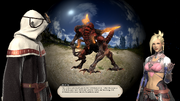
Minfilia explains the spirit energies of Hydalyn.
- The circle of birth, life, and death in Hydaelyn works in the same way as Spira's. When a living being dies, it returns to the aetherial realm and reincarnates into a new life. The spirit energies in the realm are called "Lifestream", the term from Final Fantasy VII. Primals can be called from these energies similar to how the summoners in Spira call their aeons that manifest from pyreflies.
- Garlean machines are referred to as "machina," a term used in Spira to refer to machines before the Eternal Calm.
- The boss room of the Tam-Tara Deepcroft is called "Eternal Calm." Eternal Calm is a state Spira longs for in Final Fantasy X where Sin would never return.
- The Relic Weapon for White Mages is Nirvana.
- During the 2014 Heavensturn (New Year) event, during the year of the horse, an argument between the Chief "Chocowhacker" and the far eastern Uma Bugyo contains the following line: "As for your precious horses, they're just unicorns with a big empty forehead! Hornless! Hornless!" This alludes to Biran and Yenke Ronsos' mocking of Kimahri Ronso for his broken horn in Final Fantasy X.
- The battle against Bismarck is reminiscent of the battle against Sin in terms of them both being giant flying whales fought in the air, while the mechanics of the fight also recall the battle against Evrae.
- There is a battle strategy for Forgall, the second boss of the Weeping City of Mhach, that the players can get a zombification debuff in order to avoid getting killed by the boss' spell Mega Death, the same strategy that the player can use during the fight against Yunalesca.
- Rikku, Yuna, and Lulu appear as minions.
- Yojimbo appears as the last boss of Kugane Castle and is an important character in the Hildibrand storyline in Stormblood. He uses the same model as his Final Fantasy X counterpart. His ultimate attack Zanmato's damage depend on the amount of gold Daikoro collected. In Final Fantasy X, the player must pay gil to Yojimbo for him to use his best moves.
- In the realm of The First, the Hrothgar feline race are known as the Ronso, being named after the feline race of the same name from Final Fantasy X.
- The region Amh Araeng has locations known as the ruins of Kelk, Mount Biran, and Garik, all named after historical notes of the Ronso race. These names derive from Ronso characters Kelk Ronso and Biran Ronso from Final Fantasy X and Garik Ronso from Final Fantasy X-2.
- Similar to Dream Zanarkand, the city of Amaurot is created by Emet-Selch from the memories of the original city. Like Dream Zanarkand, the inhabitants of the city live life normally and are unaware of their true nature.
Final Fantasy X-2
- Soul crystals have inscriptions related to past warriors' deeds and, when equipped, allow the player to use a job related to those warriors. This concept is similar to that of dresspheres in Final Fantasy X-2.
- The Arcanist quest is titled "A Thousand Words" which is a reference to the song Yuna sings in Final Fantasy X-2.
Final Fantasy XI
- (1.0) The server Selbina referred to a town of the same name.
- (1.0) Two of the Achievement NPCs bear the last name of "Ironheart," a reference to the famous cartographer Gwynham Ironheart. They are Milith Ironheart (in charge of Dungeons) and Nedrick Ironheart (in charge of Exploration). The two have switched roles after 2.0, as Milith is now the character who gives the adventurer access to the Sightseeing Log, and Nedrick is present as the quest giver for various dungeons apart from the main story, such as the Sunken Temple of Qarn and Amdapor Keep.
- (1.0) The NPC responsible for unlocking the battle category of achievements was named Atelloune, sharing her name with a minor NPC present in Final Fantasy XI. Both of them are researching monsters, wear the exact same outfit and are of similar races (Elvaan/Elezen).
- All of the playable races are derived from the Final Fantasy XI races, although there are enough differences that they are likely not connected (namely the female Roegadyn).
- Several beast tribes, namely the Qiqirn, Mamool Ja, Gigas, and Goblins, are upscaled versions of their Final Fantasy XI models. Many other monsters are taken from Final Fantasy Final Fantasy XI, Final Fantasy XII, and Final Fantasy XIII.
- The design of chocobos are based on the chocobos from Final Fantasy XI.
- The original beastmen from 1.0 were likely derived from beastmen in Final Fantasy XI as well. The Ixal are flightless birds like the Yagudo, the Amalj'aa strongly resemble Mamool Ja, and the Kobolds are reminiscent of Goblins (or more specifically their subterranean brethren, the Moblins). Goblins and Mamool Ja were not introduced until long after 1.0's release.
- The primal, Garuda strongly resembles the design for the Final Fantasy XI Garuda in that she is a pale green winged woman.
- Several weapons from the Grand Companies of Eorzea lore are direct references to important characters and weapons from Final Fantasy XI.
- Both the names of the artifact and vintage armor sets for all jobs (e.g. Healer's/Cleric's gear) are identical to the names of the two artifact armor sets in Final Fantasy XI.
- The Pugilists's Guild's introductory statements refer to a woman named Cornelia, who founded the guild. This is a reference to a Monk of the same name in Final Fantasy XI.
- The first name of Raubahn Aldynn, the leader of the Grand Company Immortal Flames, is identical to Raubahn, the captain of the Immortals in Final Fantasy XI.
- Among Eorzean NPCs, Thaumaturges are predominately Lalafell, much like the Tarutaru of Windurst are strongly tied to Black Magic, particularly Shantotto.
- More specifically, Shantotto is frequently alluded to in all things relevant to the Black Mage job:
- A legendary female Black Mage named "Shatotto" was the bearer of the Soul of the Black Mage (BLM's Job Crystal, a.k.a. Shatotto's Stone), which was used to seal the voidgate.
- Shatotto was the creator and wielder of the original Stardust Rod. In the quest line to obtain the recreated rod, the relic smith Gerolt mistakenly calls her "Shantotto."
- She is also referred to by the achievement "Ohohohohoho!" granted by obtaining the Stardust Rod Relic Weapon.
- Black Mage's victory pose is based on Shantotto's iconic laughing.
- Shantotto appeared in a cross-game collaboration event between Final Fantasy XI, Final Fantasy XIV: A Realm Reborn, and Dragon Quest X, Square Enix's three MMORPGs.
- The Shadow Lord's name is used in example sentences for the chat log filtering configuration.
- The Mammet in the Goldsmith quest line, Gigi, is considered the first Mammet. His original name is Mnejing.
- An NPC in the Weaver's guild sings the line "Distant worlds together. Miracles from realms beyond" from the song "Distant Worlds" in a speech bubble while she spins thread.
- Fenrir appears as the final boss of Snowcloak, and both his appearance and his abilities (such as Lunar Cry) are similar to that of his Final Fantasy XI incarnation.
- The gatekeeper for the Ninja headquarters in Final Fantasy XIV speaks the word "Ayame", to which the password that must be replied is "Kaede". Ayame and her sister Kaede are both figures in the Ninja questline of Final Fantasy XI.
- The bosses of Wanderer's Palace (Hard) seems to be based on the following Mamool Ja Notorious Monsters from Final Fantasy XI in terms of looks and design:
- Frumious Koheel Ja is based on Lancelord Gaheel Ja.
- Slithy Zolool Ja is based on Sagelord Molaa Ja.
- Manxome Molaa Ja Ja is based on Gulool Ja Ja.
- Numerous Miqo'te names are taken from Final Fantasy XI; see Miqo'te/Naming for details.
- The enemies inside the hard mode version of the Lost City of Amdapor are upgraded models of the enemies from Final Fantasy XI. The Void Monk is based on the Sea Monk enemies, Mana Idols are based on the Doll enemy class, and the Mana Pots are based on the Magic Pot enemies.
- The Ghrah Luminary in Pharos Sirius (Hard) is identical to other Ghrah encountered in Final Fantasy XI, such as Jailer of Fortitude, but dark orange instead of silver.
- One Void Ark boss, Cetus, is very similar to the same boss encountered in Rhapsodies of Vana'diel.
- Reisen Temple uses the same music as Reisenjima from Final Fantasy XI. It also includes references to Tenzen and multiple bosses interlinked in a similar concept.
Final Fantasy XII
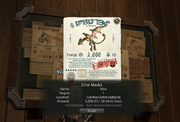
The hunt board.
- (1.0) The server Rabanastre referred to a city of the same name from Final Fantasy XII.
- The Imperial Legatus armor designs are based on the Archadian Judge's armor from Final Fantasy XII.
- A scene with Nael van Darnus marching, followed by a few Garlean soldiers, resembles the Archadian judges marching towards the screen during the opening of Final Fantasy XII. The same can be said of Gaius van Baelsar and his Tribunes during the events of Final Fantasy XIV: A Realm Reborn.
- Members of the Ascians who worship Zodiark, are named after the Scions of Light mentioned in profiles on the Espers in Final Fantasy XII.
- When fighting the Ascian Nabriales during the Chrysalis trial, he will use certain abilities that first appeared in Final Fantasy XII. His damage over time attack, Blight, is named after the special attack of the same name used by the Esper Cúchulainn, who was the Scion of Darkness that opposed Nabriales, the Majestic. He also uses Dark IV (ダージャ, Dāja?, lit. Darkja) as his special attack during the battle, with Dark IV's spell animation strongly resembling Zodiark's Darkja spell used during the boss fight against it inside the Henne Mines.
- The primal essences that can be called forth by the Summoner are called egi, an allusion to Garuda-Egi boss in Final Fantasy XII.
- Likewise, the last battle from the Summoner quest line is against Belias-Egi, the essence of Belias, the first Esper the player is likely to fight in Final Fantasy XII.
- In general, Final Fantasy XIV: A Realm Reborn reuses an enormous number of creature models, and in certain cases even textures, from various Final Fantasy XII enemies.
- The Feral Croc and Mirrorknight enemies are reused directly; the Mirrorknights also receive a new version called "Dreadknight" in the Binding Coil of Bahamut, with an updated texture.
- The model of the Basilisk enemy is heavily reused as the design for various serpent enemies, ranging from low-level monsters to major bosses like Caduceus in the Binding Coil of Bahamut (in the latter's case, the texture has been updated substantially).
- The Scythe Mantis and some of its cousins also feature directly in the game, again with fairly un-updated textures. As with the serpents, mantises also appear in the Binding Coil, where they also receive a major texture revision.
- The Qarn Facer enemies and the Adjudicator boss inside the Sunken Temple of Qarn use the same models as those of the Miriam Facer and Miriam Guardian enemies from the Stilshrine of Miriam, but again with substantially updated textures.
- The Clockwork Bug enemies found inside Turn 4 of the Binding Coil of Bahamut are the same model as that of the Mimic enemies from Final Fantasy XII.
- The Spinner-Rook is also reused directly in the same Turn; even retaining the "Pox" ability.
- The dragons of the Dravanian Horde use a large number of "dragon" models from Final Fantasy XII—the Aevis dragon-soldiers use the model, animations and even the wholly unmodified texture of the Cataract Aevis (with the "Jura Aevises" found later in Stone Vigil Hard Mode using the texture of the Archaeoaevis instead); "smaller" four-legged dragons, including Stone Vigil boss Chudo-Yudo or hunt mark Maracco, reuse the model and texture of the Ring Wyrm (sans its iconic rings); the general model and design of Tyrant is used for a number of enemies, including Tyrant himself in Pharos Sirius, and the Stone Vigil Hard Mode boss Gorynich, reuses a model and design similar to that of the Fafnir mark.
- The first boss of Halatali is named Firemane; curiously, the model for the creature is that of a "normal" fire elemental.
- The "ADS" and similar enemies in the Binding Coil take some design cues from the Sphere-Rook; unlike many of the above examples, however, this is only very general visual cues, as the actual models, textures and animations are unique.
- Giruveganaus, the last boss of the Stone Vigil (Hard Mode) is based on Giruveganus.
- Players can accept hunt requests from the billboard in all three Grand Companies. It is an allusion to the hunt sidequests in Final Fantasy XII.
- Clan Centurio makes an appearance in Final Fantasy XIV: Heavensward. Returning as a clan of hunters they give players mark bills and reward them with Centurio Seals upon defeating Marks. In Final Fantasy XII Clan Centurio was an elite hunting club the player could join.
- The Mandragora royals appear in a sidequest involving Hildibrand.
- The King Tomato minion alludes to the Rogue Tomato mob with a quote: "It is apparently a rogue, outcast from its kin, a stranger in a strange land" attributed to Tomaj. In Final Fantasy XII, Tomaj tasks Vaan to fell the Rogue Tomato as the first hunt.
- Tomato King is also an enemy in the game.
- Targeted enemies for Hunt sidequests will have a Tomato King icon on their name plate.
- The Gnath Beastmen are modeled after the Urutan-Yensa from Final Fantasy XII.
- In the stinger for the Patch 3.1 Main Scenario Quest "As Goes Light, So Goes Darkness", Urianger discusses a book called the Gerun Oracles, which shares its name with the Occurian king.
- Kuribu, the final boss of the hard mode version of the Lost City of Amdapor, uses the Reverse and Decoy abilities, spells that first appeared in Final Fantasy XII.
- The bangaa, seeq, and viera races are native to the region of Dalmasca. Similar to Final Fantasy XII, the viera of Hydaelyn hail the Golmore Jungle and tend to avoid interaction with the outside world.
- In the "Return to Ivalice" arc, the Royal City of Rabanastre and Ridorana Lighthouse alliance raids are based on Rabanastre and the Pharos of Ridorana, and are located in the Dalmasca region. The raid series contains the following references to Final Fantasy XII:
- Rabanastre has much in common with its Final Fantasy XII counterpart, as both kingdoms are located in the heart of a desert region, contain an aqueduct system known as the Garamsythe Waterway, and both are the birthplaces of their game's versions of Princess Ashelia B'nargin Dalmasca.
- A version of Prince Rasler Heios Nabradia appears as a historical figure in the Return to Ivalice series. However, this version of Ralser is named Rasler B'nargin Dalmasca, and is part of the Dalmasca royal family as Ashelia's twin brother. Similar to his original counterpart, Prince Rasler is murdered in an imperial attack on the Dalmasca region.
- A version of Fran original to the world of Final Fantasy XIV appears. Her appearance is largely the same, albeit somewhat smaller than her original counterpart. She leads the Lethe's Tears resistance, which was the name of an important key item needed to pass through the Golmore Jungle in Final Fantasy XII.
- Ba'Gamnan and his siblings appear as the initial antagonists during the opening portions of the "Return to Ivalice" series.
- Waypoints in the Rabanastre raid are modeled after the save points appeared in Final Fantasy XII.
- The Final Fantasy XII versions of Mateus, the Corrupt and Hashmal, the Bringer of the Order appear as the first two bosses in the Royal City of Rabanastre raid; while Famfrit, the Darkening Cloud and Belias, the Gigas also appear in a similar manner in the Ridorana Lighthouse. Like their appearances in Final Fantasy XII, these bosses use -ja tier spells (localized as IV-tier spells) and their signature attacks when summoned as Espers.
- Yiazmat appears as the final boss of the Ridorana Lighthouse raid. His appearance in Final Fantasy XIV is somewhat similar to the superboss's original appearance.
- Ultima, the High Seraph also appears as the main antagonist of the Return to Ivalice series. While not directly resembling her Final Fantasy XII appearance, her overall design bears some resemblance to it, albeit lacking a mechanical bottom half. In addition, she is able to use Holy IV and Redemption, referencing her special attacks in Final Fantasy XII.
- Balthier's outfit appears as the ranged DPS exclusive gear in the Orbonne Monastery alliance raid. In addition, an official screenshot released by Square Enix to promote the "Return to Ivalice" arc features a player character who looks like Balthier.

Minfilia asking Uimet about her age.
- The scene of Minfilia asking the Viis Uimet about her age alludes to Vaan asking Fran her age in Final Fantasy XII. However, Uimet being asked in Final Fantasy XIV does not seem to be annoyed like Fran was.
Final Fantasy XIII
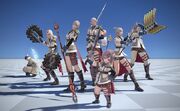
Lightning's outfit, Snow's outfits, and weapons from the Lightning Saga.
- (1.0) The server Bodhum referred to a city of the same name from Final Fantasy XIII.
- The Eshtaime Lapidaries (Goldsmith guild) of the Ul'dah city-state are based on the surname of Hope Estheim, a playable character in Final Fantasy XIII.
- Players who participated in the Full Active Time Event, "Lightning Strikes," could acquire a Lightning costume for females or a Snow costume for males, and weapons from Final Fantasy XIII, Final Fantasy XIII-2, and Lightning Returns: Final Fantasy XIII. These items were eventually released on the game's Mog Station online store.
- Some of the Pulse/Ancient Automata-type enemies are reused as enemies in Final Fantasy XIV: A Realm Reborn. The Beta Behemoth enemy is also brought into the game during the Lightning Strikes storyline.
- During the event Lightning Strikes, there is a Harbor Herald article entitled "The Trinkets of Eshtaime's Lapidaries Fail to Strike Lightning's Fancy," linking Lightning's emergence to Eorzea's native allusion to Hope Estheim.
- Lightning and Snow's hairstyles are available for player characters after finishing event Lightning Strikes and "Beauty Is Only Scalp Deep" sidequest.
- Jandelaine, the aesthetician non-player character, begins his service by turning a female Lalafell's hair into Lightning's hairstyle.
- Ruin appears as an Arcanist ability. It shares the same animation and effect with its Final Fantasy XIII counterpart.
- In the quest "Rolling With The Snowies" in Coerthas Central Highlands, the snowman says "Revolutionaries always get called crazy." The same line was used by Fang in Final Fantasy XIII.
- An NPC in the All Saints Wake 2014 event quest "Yes We Cant" uses the phrase "sugar and rainbows." "Sugar and rainbows" was said by Sazh Katzroy in Final Fantasy XIII.
Final Fantasy XIII-2
- Serah Farron's starting weapon, the Starseeker and Mog's Staff can be obtained from one of the "Lightning Strikes" event.
- The Aspect of Chaos, the last boss of the "Lightning Strikes" event, shared the same model with Chaos Bahamut.
- Ultros appears as a smaller version of how he appeared in Final Fantasy XIII-2. When he loses to the party he got cooked up similar to the event of Final Fantasy XIII-2.
- The Manderville Gold Saucer sidequest name "So You Think You Can Ride This Chocobo" refers to the lyrics from the "Crazy Chocobo" theme from Final Fantasy XIII-2.
Lightning Returns: Final Fantasy XIII
- A weapon conjured by Snow Villiers and briefly used by him in the opening, called the l'Cie Bardiche in Final Fantasy XIV, could be obtained from one of the FATEs during the temporary event "Lightning Strikes".
Final Fantasy XV
"A Nocturne for Heroes" was a Final Fantasy XIV x Final Fantasy XV collaboration, which allowed players to fight alongside Noctis.
- Noctis's vehicle, the Regalia was obtainable as a mount in the event.
- Noctis's gear was also obtainable in the event.
Final Fantasy Type-0
- The hairstyles of Class Zero cadets are available for player characters. Cater, Cinque, Nine, and Jack's hairstyles were made available since version 3.2. Seven's hairstyle was implemented later in version 3.3. Ace, Queen, and King's for version 3.4, and Deuce, Trey, and Sice's for version 3.5.
- The imperial salute of the Garlean Empire is the same as the Militesi Empire salute.
Final Fantasy Tactics
- When Cid nan Garlond hiding his identity while living in Thanalan, he wears a brown hooded cloak similar to the Cid of Final Fantasy Tactics, Cidolfus Orlandeau. This similarity is brought up during the Orbonne Monastery raid. Upon encountering Cidolfus, an NPC initially mistakes him as Cid.
- There are several references to a Corpse Brigade led by Milleuda the Slitter, in Full Active Time Events and guildleves.
- In one quest, there's line uttered by the cowardly merchant, Ungust, that quotes, "Spare me your contempt! If you want to blame someone for the mess the world's in, blame yourselves or the gods!" A line Delita Heiral says in the beginning of the PS version of Final Fantasy Tactics to Princess Ovelia Atkascha (it was changed to "'Tis your birth and faith that wrong you... not I" in the War of the Lions version).
- In the Japanese version, Lahabrea's incantation for casting Ultima during the cutscene inside the Praetorium is loosely based on Ultima's incantation for her Divine Ultima ability when fighting her in the Airship Graveyard.
- The dark deity Zodiark is represented by a character called Elidibus, named after an optional superboss fought at the bottom of the Midlight's Deep in Final Fantasy Tactics; Zodiark appeared as a summon used in battle by Elidibus, who was implied to have pledged his soul to the dark being.
- The Veil of Wiyu and the Omnilex are the Summoner and Scholar relic weapons.
- Construct 8 appears as an enemy in Pharos Sirius (Hard).
- In the "Return to Ivalice" raid series, Arazlam Durai (under his playwright name Jenomis cen Lexentale) appears as an important non-player character, with two of his children named after Ramza and Alma Beoulve: Ramza bas Lexentale and Alma bas Lexentale.
- Cid Garlond and Jenomis are old friends, echoing Cidolfus Orlandeau and Barbaneth Beoulve's past friendship in Final Fantasy Tactics.
- Argath Thadalfus appears as the last boss of the Royal City of Rabanastre. This version of Argath becomes a Lucavi, mimicking his original counterpart's fate of becoming a servant for the demons in the War of the Lions versions of Final Fantasy Tactics.
- Ramza Beoulve, Alma Beoulve, Delita Heiral, and Orran Durai were mentioned.
- The death of Delita's sister was mentioned and is guessed to be the cause of Delita and Ramza to went separate ways.
- The Orbonne Monastery appears as an alliance raid. Similar to the original location from Final Fantasy Tactics, the monastery also serves as an entrance to the Necrohol of Mullonde and ultimately leads to a final encounter with Ultima, the High Seraph.
- Ramza and Alma's hairstyles are available for player characters since version 4.5.
Final Fantasy Tactics Advance
- Similar to Queen Remedi summoning the Totema to aid her during the final encounter, Ultima, the High Seraph summons Famfrit, Belias, and Hashmal to aid her during her final encounter within the Orbonne Monastery raid.
- The Crystarium's hunting clan, Clan Nutsy, is named after Marche Radiuju's clan of the same name from Final Fantasy Tactics Advance.
Final Fantasy Tactics A2: Grimoire of the Rift
- A moogle by the name of Hurdy appears during the "Return to Ivalice" series, referencing the character of the same name from Final Fantasy Tactics A2. Like the original Hurdy, this version is also the brother of a moogle named Montblanc and is a bard.
- Vaan's sky pirate entire from Final Fantasy Tactics A2 appears as the melee DPS exclusive gear from the Ridorana Lighthouse raid.
Dissidia Final Fantasy
Chaos's ultimate attack in the Alphascape V1.0 raid is Soul of Chaos, which appeared as Garland's EX Burst in Dissidia Final Fantasy.
Dissidia Final Fantasy NT
- The Wind-up Kefka's description mentions that Y'shtola Rhul finds Kefka eerily familiar, which references to her encounters with Kefka in Dissidia Final Fantasy NT.
Final Fantasy Crystal Chronicles: The Crystal Bearers
- One of the titles that can be earned is "Crystal Bearer."
The Chocobo series
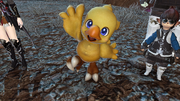
Alpha.
- The design of the chocobo Alpha is based on the chocobo from Final Fantasy Fables: Chocobo Tales. It frequently does the same pose as its original character.
Bravely Default
- Rowena mentions the phrase "Flying Fairies," a reference to the Japanese title of Bravely Default, known as Bravely Default: Flying Fairy.
Final Fantasy: The Spirits Within
- One Paladin skill is named Spirits Within.
- The Wild-Eyed Swordsmen fought in the Akh Afah Amphitheatre have an ability called Spirits Without.
Final Fantasy Adventure
- On The First, Watts is the name of a legendary Dwarf blacksmith, who has several items and locations named for him. Watts is a Dwarf blacksmith in Final Fantasy Adventure.
Triple Triad
- Thirteen lead protagonists of the past thirteen main Final Fantasy titles appear as a legendary card using their Dissidia artwork:



